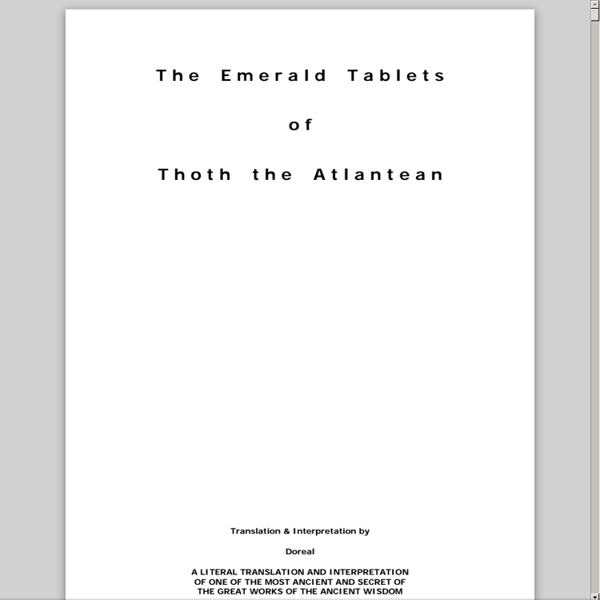



alchemical archives Kybalion Modern Hermetic tract The Kybalion (full title: The Kybalion: A Study of the Hermetic Philosophy of Ancient Egypt and Greece) is a book originally published in 1908 by "Three Initiates" (often identified as the New Thought pioneer William Walker Atkinson, 1862–1932)[1] that purports to convey the teachings of Hermes Trismegistus. Seven Hermetic principles[edit] A central concept in the book is that there are "seven Hermetic principles, upon which the entire Hermetic philosophy is based".[4] These are, as literally quoted from the book: 1. "The All is Mind; the Universe is Mental 2. 3. "Nothing rests; everything moves; everything vibrates 4. "Everything is dual; everything has poles; everything has its pair of opposites; like and unlike are the same; opposites are identical in nature, but different in degree; extremes meet; all truths are but half-truths; all paradoxes may be reconciled 5. 6. 7. Relation to ancient and medieval Hermetica[edit] See also[edit] References[edit] Works cited
The New Alchemy - Alan Watts Alan Watts an essay from This is It and Other Essays on Zen and Spiritual Experience, by Alan Watts, Vintage Books, 1973, copyright Alan Watts 1958, 1960. This essay was written in 1960. Besides the philosopher's stone that would turn base metal into gold, one of the great quests of alchemy in both Europe and Asia was the elixir of immortality. To many people such claims are deeply disturbing. However, it should be pointed out that there is nothing new or disreputable in the idea that spiritual insight Is an undeserved gift of divine grace, often conveyed through such material or sacramental means as the water of baptism and the bread and wine of the mass. A chemical of this kind might perhaps be said to be an aid to perception in the same way as the telescope, microscope, or spectroscope, save in this case that the instrument is not an external object but an internal state of the nervous system. This sensation raised a number of questions.
Emerald Tablet of Hermes Sacred-Texts Esoteric Index Previous Next The Emerald Tablet of Hermes History of the Tablet History of the Tablet (largely summarised from Needham 1980, & Holmyard 1957) The Tablet probably first appeared in the West in editions of the psuedo-Aristotlean Secretum Secretorum which was actually a translation of the Kitab Sirr al-Asar, a book of advice to kings which was translated into latin by Johannes Hispalensis c. 1140 and by Philip of Tripoli c.1243. Translations From Jabir ibn Hayyan. 0) Balinas mentions the engraving on the table in the hand of Hermes, which says: 1) Truth! Another Arabic Version (from the German of Ruska, translated by ‘Anonymous'). 0) Here is that which the priest Sagijus of Nabulus has dictated concerning the entrance of Balinas into the hidden chamber... Twelfth Century Latin Translation from Aurelium Occultae Philosophorum..Georgio Beato 1) This is true and remote from all cover of falsehood 2) Whatever is below is similar to that which is above. From Idres Shah
Hermetica Scope[edit] The term particularly applies to the Corpus Hermeticum, Marsilio Ficino's Latin translation in fourteen tracts, of which eight early printed editions appeared before 1500 and a further twenty-two by 1641.[2] This collection, which includes the Pœmandres and some addresses of Hermes to disciples Tat, Ammon and Asclepius, was said to have originated in the school of Ammonius Saccas and to have passed through the keeping of Michael Psellus: it is preserved in fourteenth century manuscripts.[3] The last three tracts in modern editions were translated independently from another manuscript by Ficino's contemporary Lodovico Lazzarelli (1447–1500) and first printed in 1507. Extensive quotes of similar material are found in classical authors such as Joannes Stobaeus. Character and antiquity[edit] The extant Egyptian-Greek texts dwell upon the oneness and goodness of God, urge purification of the soul, and defend pagan religious practices, such as the veneration of images. I. (II.) V.
Imhotep, Doctor, Architect, High Priest, Scribe and Vizier to King Djoser About Egyptian Pyramids by Jimmy Dunn Of the non royal population of Egypt, probably one man is known better than all others. He was the world's first named architect who built Egypt's first pyramid, is often recognized as the world's first doctor, a priest,. scribe, sage, poet, astrologer, and a vizier and chief minister, though this role is unclear, to Djoser (reigned 26302611 BC), the second king of Egypt's third dynasty. Of the details of his life, very little has survived though numerous statues and statuettes of him have been found. Inscription with the names of Netjerikhet (Djoser) and Imhotep Imhotep may have been born in Ankhtow, a suburb of Memphis early in Egyptian history. As the High Priest of Heliopolis, he would have been one of the chief priest of Lower (northern) Egypt. Imhotep's best known writings were medical text. Sir William Osler tells us that Imhotep was the: "..first figure of a physician to stand out clearly from the mists of antiquity." References:
Angels rpus Hermeticum Background for Ars Magica sagas The Corpus Hermeticum is a collection of texts from the second and third centuries of our era that survived from a more extensive literature. Reflecting the generalized spiritual orientation of late Hellenistic gnosis rather than a tradition in any organized sense, these sometimes contradictory texts share only their claim to a common source of revelation, Hermes Trismegistus. In most of the texts his revelations are presented as a dialogue with one of three pupils: Tat, Asclepius, or Ammon. According to Augustine[115], Asclepius was the grandson of the great Greek god of the same name, and Tat was likewise the grandson of his divine namesake (the Roman deity Mercurius, the same as the Greek god Hermes). The Hermetic texts are often cited as examples of the extent of late Hellenistic syncretism, for they exhibit traits of magic, astrology, alchemy, Platonism and Stoicism, and the Mysteries, as well as Judaism and gnostic thought. Hermetic Collections
Association for the Study of Esotericism